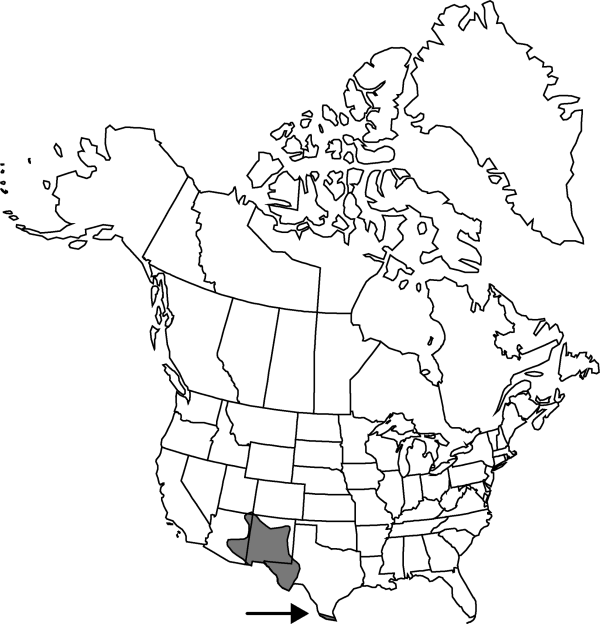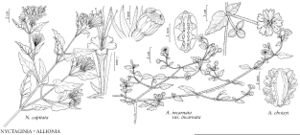Difference between revisions of "Allionia choisyi"
Publ. Field Mus. Nat. Hist., Bot. Ser. 8: 310. 1931.
FNA>Volume Importer |
FNA>Volume Importer |
||
| Line 20: | Line 20: | ||
}}<!-- | }}<!-- | ||
| − | --><span class="statement" id="st- | + | --><span class="statement" id="st-undefined" data-properties=""><b>Herbs,</b> annual [probably also perennial], glabrate to viscid pubescent. <b>Stems</b> often reddish, 0.1–0.7[–2] m. <b>Leaves</b> progressively reduced distally; distal leaves proportionately narrower than proximal; larger leaves: petiole 2–18[–30] mm, equaling or shorter than blade; blade usually undulate, sometimes flat, 10–30 × 6–22 mm, base often oblique, obtuse, or round, margins sinuate, sometimes entire, apex narrowing to rounded tip, obtuse, or acute. <b>Inflorescences</b>: peduncle 1–9(–12) mm; involucres broadly ovoid to spheric when mature, 4–7.5 mm. <b>Perianth</b> pale pink to magenta [nearly white], 2–7 mm. <b>Fruits</b> shallowly convex, 3.2–4.3 × 1.8–3.7 mm; lateral ribs with 4–8 teeth, teeth slender and attenuate, sometimes gland tipped [rarely mostly entire with short-toothed margin], concave side of fruit with 5–7 glands per row; stalk equaling or longer than diameter of glandular head.</span><!-- |
-->{{Treatment/Body | -->{{Treatment/Body | ||
| + | |phenology=Flowering late spring–early fall [year-round]. | ||
|habitat=Open arid areas, often on sandy or gravelly soils, sometimes on clay or gypsum | |habitat=Open arid areas, often on sandy or gravelly soils, sometimes on clay or gypsum | ||
|elevation=[0-]800-1600[-2500] m | |elevation=[0-]800-1600[-2500] m | ||
| Line 43: | Line 44: | ||
|basionyms=Allionia incarnata var. glabra | |basionyms=Allionia incarnata var. glabra | ||
|family=Nyctaginaceae | |family=Nyctaginaceae | ||
| + | |phenology=Flowering late spring–early fall [year-round]. | ||
|habitat=Open arid areas, often on sandy or gravelly soils, sometimes on clay or gypsum | |habitat=Open arid areas, often on sandy or gravelly soils, sometimes on clay or gypsum | ||
|elevation=[0-]800-1600[-2500] m | |elevation=[0-]800-1600[-2500] m | ||
| Line 50: | Line 52: | ||
|publication year=1931 | |publication year=1931 | ||
|special status= | |special status= | ||
| − | |source xml=https://jpend@bitbucket.org/aafc-mbb/fna- | + | |source xml=https://jpend@bitbucket.org/aafc-mbb/fna-data-curation.git/src/9216fc802291cd3df363fd52122300479582ede7/coarse_grained_fna_xml/V4/V4_117.xml |
|genus=Allionia | |genus=Allionia | ||
|species=Allionia choisyi | |species=Allionia choisyi | ||
| − | |||
| − | |||
| − | |||
| − | |||
| − | |||
| − | |||
| − | |||
| − | |||
| − | |||
| − | |||
| − | |||
| − | |||
| − | |||
| − | |||
| − | |||
| − | |||
| − | |||
| − | |||
| − | |||
| − | |||
| − | |||
| − | |||
| − | |||
| − | |||
| − | |||
| − | |||
| − | |||
| − | |||
| − | |||
| − | |||
| − | |||
| − | |||
| − | |||
| − | |||
| − | |||
| − | |||
| − | |||
| − | |||
| − | |||
}}<!-- | }}<!-- | ||
-->[[Category:Treatment]][[Category:Allionia]] | -->[[Category:Treatment]][[Category:Allionia]] | ||
Revision as of 13:56, 27 July 2019
Herbs, annual [probably also perennial], glabrate to viscid pubescent. Stems often reddish, 0.1–0.7[–2] m. Leaves progressively reduced distally; distal leaves proportionately narrower than proximal; larger leaves: petiole 2–18[–30] mm, equaling or shorter than blade; blade usually undulate, sometimes flat, 10–30 × 6–22 mm, base often oblique, obtuse, or round, margins sinuate, sometimes entire, apex narrowing to rounded tip, obtuse, or acute. Inflorescences: peduncle 1–9(–12) mm; involucres broadly ovoid to spheric when mature, 4–7.5 mm. Perianth pale pink to magenta [nearly white], 2–7 mm. Fruits shallowly convex, 3.2–4.3 × 1.8–3.7 mm; lateral ribs with 4–8 teeth, teeth slender and attenuate, sometimes gland tipped [rarely mostly entire with short-toothed margin], concave side of fruit with 5–7 glands per row; stalk equaling or longer than diameter of glandular head.
Phenology: Flowering late spring–early fall [year-round].
Habitat: Open arid areas, often on sandy or gravelly soils, sometimes on clay or gypsum
Elevation: [0-]800-1600[-2500] m
Distribution

Ariz., N.Mex., Tex., Utah, Mexico, West Indies, Central America, South America.
Discussion
The low, broad fruit of Allionia choisyi resembles a small, clinging tick, hence the Spanish name “garapatilla.” Occasionally the fruits are strongly convex, others may have four moderately slender teeth; in either case the fruits are intergradient to the few-toothed, strongly convex fruits of A. incarnata. Such plants are most commonly found in southeastern Arizona and in arid south-central Texas. Plants with fruits shaped as those in A. choisyi, with glands on the concave surface with tall stalks but with entire or nearly entire, curved, lateral ribs occur occasionally in South America. Collectors have noted that A. choisyi plants hug the ground more closely than those of A. incarnata. Throughout much of its range in North America, A. choisyi has leaves with strongly pleated-undulate blades. Very small, pale pink to white flowers are also more common in A. choisyi, especially in Mexico.
In the flora area Allionia choisyi is usually an annual. In Mexico, plants often appear to be perennial.
Selected References
None.
